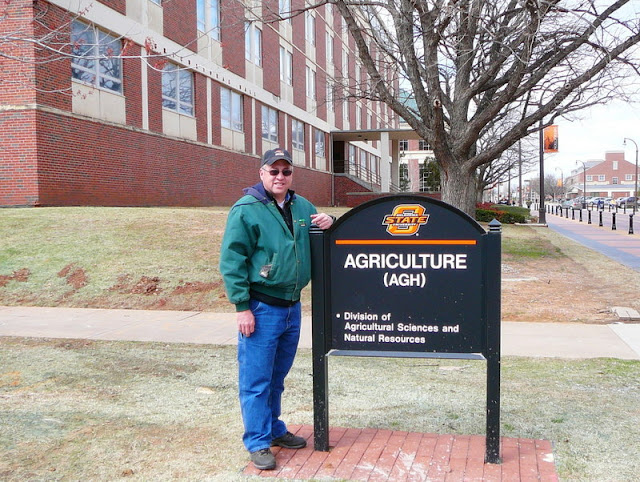So this week I made the trip down to Oklahoma, my former home. I took a quick visit to the campus of Oklahoma State University, which has the most beautiful campus in the world, to see what was going on. Below I am outside my old building of Ag Hall, where I used to have an office up on the 4th floor when working on my Master's degree. I'm sure they haven't dared to alter it since I left a few years ago. OK, a lot of years ago. It was way cold this week. Didn't expect to be wearing a coat.
Today I spent with Area Manager Todd Woods of Perry, OK. He grows wheat himself and also has a number of growers in the area who have used AgroLiquid on their wheat. Todd is smart in understanding that Liquid (and all) fertilizer works best when the pH is correct. He has promoted liming to his customers and they are seeing the benefits. Here Todd is checking the pH with a portable probe.
We looked at a number of fields around the county that had Liquid fertilizer on them. They really stood out, like this one here. They usually applied 4 to 5 gallons per acre of Pro-Germinator with Micro 500 through the drill at planting. Some also applied Sure-K where needed. And most were topdressed with 28-0-0-5 with eNhance. We are working on a newer faster acting nitrogen in research trials that should give a quicker response with nutrient balance for the future. Here is one of Todd's own fields.
This grower switched from anhydrous and dry a number of years ago and has seen big improvements in his wheat pasture. The pH has mellowed and the balance of phosphorus and micronutrients has fed more cows than before. He's kind of embarrased to relate how much more he is netting on the cattle operation since paying better attention to the wheat nutrient program. Don't even joke about switching back with these happy cows.
We saw a couple of these fields where OSU had what they called "N Rich Strips". I'm not sure of the rate here as it didn't say, but you couldn't see a difference at this time between the strip and the rest of the field. You probably can later, we will see. I went to the web site and I think it's for calibration of the Greenseeker, maybe. Or just to compare high rates of N with farmer practice. I will have to find out more about this, maybe.
Here is another good looking field fed with AgroLiquid. I will say that as good as these look now, some rain would sure help. This is a common observation around the Midwest and Plains states.
Later on Todd picked up his 16 month old son to help with the field check of the last field we visited today. I sure would buy fertilizer from him, wouldn't you?
Well there is plenty more to come this week, so stay tuned.






